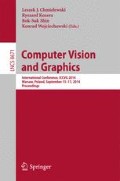Abstract
In some imaging setups the following assumptions hold: the objects are opaque and viewed only from one point, their surface is continuous at least piecewise, and the occluding objects are small with respect to the viewed objects. In addition, in the application of our interest the images can be treated similarly to the case of the plane of light. This made it possible to design algorithms with some desired features: the segmentation based on sorting the data according to angle and the version of the object verification method using fuzzy voting with the positive and negative evidence. The algorithms have some opposite and complementary features which could be used in application to LIDAR data in the measurements of trees and forest.
Access this chapter
Tax calculation will be finalised at checkout
Purchases are for personal use only
Preview
Unable to display preview. Download preview PDF.
References
Ballard, D., Brown, C.M.: Computer Vision. Prentice Hall, Englewood Cliffs (1982)
Bolc, L., Tadeusiewicz, R., Chmielewski, L.J., Wojciechowski, K. (eds.): ICCVG 2012. LNCS, vol. 7594. Springer, Heidelberg (2012)
Brolly, G., Király, G., Czimber, K.: Mapping forest regeneration from terrestrial laser scans. Acta Silvatica et Lignaria Hungarica 9, 135–146 (2014), doi:10.2478/aslh-2013-0011
Brown, C.M., Curtiss, M.B., Sher, D.B.: Advanced Hough transform implementations. In: Bundy, A. (ed.) Proc. 8th Int. Joint Conf. Artificial Intelligence, IJCAI 1983, pp. 1081–1085. William Kufmann, Karlsruhe (1983)
Chmielewski, L.J., Bator, M.: Hough transform for opaque circles measured from outside and fuzzy voting for and against. In: Bolc, et al. (eds.) [2], pp. 313–320, doi:10.1007/978-3-642-33564-8_38
Czúni, L., Csordás, D.: Depth-based indexing and retrieval of photographic images. In: García, N., Salgado, L., Martínez, J.M. (eds.) VLBV 2003. LNCS, vol. 2849, pp. 76–83. Springer, Heidelberg (2003)
Frejlichowski, D.: Analysis of four polar shape descriptors properties in an exemplary application. In: Bolc, L., Tadeusiewicz, R., Chmielewski, L.J., Wojciechowski, K. (eds.) ICCVG 2010, Part I. LNCS, vol. 6374, pp. 376–383. Springer, Heidelberg (2010)
Frejlichowski, D., Forczmański, P., Nowosielski, A., Gościewska, K., Hofman, R.: SmartMonitor: An approach to simple, intelligent and affordable visual surveillance system. In: Bolc, et al. (eds.) [2], pp. 726–734, doi:10.1007/978-3-642-33564-8_87
Kozera, R., Noakes, L., Szmielew, P.: Quartic Orders and Sharpness in Trajectory Estimation for Smooth Cumulative Chord Cubics. In: Chmielewski, L.J., Kozera, R., Shin, B.-S., Wojciechowski, K. (eds.) ICCVG 2014. LNCS, vol. 8671, pp. 9–16. Springer, Heidelberg (2014)
Leavers, V.F.: Shape Detection in Computer Vision Using the Hough Transform. Springer, London (1992)
Leś, T., Kruk, M., Osowski, S.: Automatic recognition of industrial tools using artificial intelligence approach. Expert Systems with Applications 40(12), 4777–4784 (2013), doi:10.1016/j.eswa.2013.02.030
Miścicki, S., Stereńczak, K.: A two-phase inventory method for calculating standing volume and tree-density of forest stands in central Poland based on airborne laser-scanning data. Forest Research Papers 74(2), 127–136 (2013), doi:10.2478/frp-2013-0013
Olofsson, K., Holmgren, J., Olsson, H.: Tree stem and height measurements using terrestrial laser scanning and the ransac algorithm. Remote Sensing 6(5), 4323–4344 (2014), doi:10.3390/rs6054323
Stereńczak, K., Zasada, M., Brach, M.: The accuracy assessment of DTM generated from LIDAR data for forest area – a case study for scots pine stands in Poland. Baltic Forestry 19(2), 252–262 (2013)
Zasada, M., Stereńczak, K., Dudek, W.M., Rybski, A.: Horizon visibility and accuracy of stocking determination on circular sample plots using automated remote measurement techniques. Forest Ecology and Management 302(0), 171–177 (2013), doi:10.1016/j.foreco.2013.03.041
Author information
Authors and Affiliations
Editor information
Editors and Affiliations
Rights and permissions
Copyright information
© 2014 Springer International Publishing Switzerland
About this paper
Cite this paper
Chmielewski, L.J., Bator, M., Olejniczak, M. (2014). Advantages of Using Object-Specific Knowledge at an Early Processing Stage in the Detection of Trees in LIDAR Data. In: Chmielewski, L.J., Kozera, R., Shin, BS., Wojciechowski, K. (eds) Computer Vision and Graphics. ICCVG 2014. Lecture Notes in Computer Science, vol 8671. Springer, Cham. https://doi.org/10.1007/978-3-319-11331-9_18
Download citation
DOI: https://doi.org/10.1007/978-3-319-11331-9_18
Publisher Name: Springer, Cham
Print ISBN: 978-3-319-11330-2
Online ISBN: 978-3-319-11331-9
eBook Packages: Computer ScienceComputer Science (R0)

